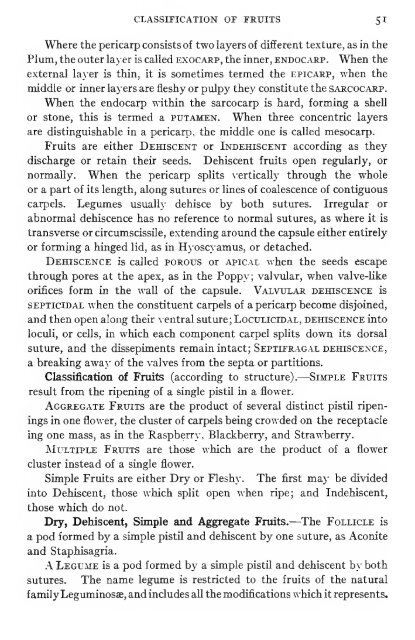Pharmaceutical botany - Lighthouse Survival Blog
Pharmaceutical botany - Lighthouse Survival Blog
Pharmaceutical botany - Lighthouse Survival Blog
You also want an ePaper? Increase the reach of your titles
YUMPU automatically turns print PDFs into web optimized ePapers that Google loves.
CLASSIFICATION OF FRUITS 5<br />
Where the pericarp consists of two layers of different texture, as in the<br />
Plum, the outer layer is called exocarp, the inner, endocarp. When the<br />
external la}"er is thin, it is sometimes termed the epicaep, when the<br />
middle or inner layers are fleshy or pulpy they constitute the sarcocarp.<br />
When the endocarp within the sarcocarp is hard, forming a shell<br />
or stone, this is termed a putamen. When three concentric layers<br />
are distinguishable in a pericarp, the middle one is called mesocarp.<br />
Fruits are either Dehiscent or Indehiscent according as they<br />
discharge or retain their seeds. Dehiscent fruits open regularly, or<br />
normally. When the pericarp splits ^'ertically through the whole<br />
or a part of its length, along sutures or lines of coalescence of contiguous<br />
carpels. Legumes usually dehisce by both sutures. Irregular or<br />
abnormal dehiscence has no reference to normal sutures, as where it is<br />
transverse or circumscissUe, extending around the capsiile either entirely<br />
or forming a hinged lid, as in Hyoscyamus, or detached.<br />
Dehiscence is called porous or apical when the seeds escape<br />
through pores at the apex, as in the Poppy; valvular, when valve-like<br />
orifices form in the wall of the capsule. Valvular dehiscence is<br />
SEPTiciDAL when the constituent carpels of a pericarp become disjoined,<br />
and then open along their ventral suture; Loculicidal, dehiscence into<br />
loculi, or cells, in which each component carpel splits down its dorsal<br />
suture, and the dissepiments remain intact; Septifragal dehiscence,<br />
a breaking awa}- of the valves from the septa or partitions.<br />
Classification of Fruits (according to structure). Simple Fruits<br />
result from the ripening of a single pistil in a flower.<br />
Aggregate Fruits are the product of several distinct pistil ripen-<br />
ings in one flower, the cluster of carpels being crowded on the receptacle<br />
ing one mass, as in the Raspberry, Blackberry, and Strawberry.<br />
JMuLTiPLE Fruits are those which are the product of a flower<br />
cluster instead of a single flower.<br />
Simple Fruits are either Dry or Fleshy. The first maj- be divided<br />
into Dehiscent, those which split open when ripe; and Indehiscent,<br />
those which do not.<br />
Dry, Dehiscent, Simple and Aggregate Fruits.—The Follicle is<br />
a pod formed by a simple pistil and dehiscent by one suture, as Aconite<br />
and Staphisagria.<br />
A Legume is a pod formed by a simple pistfl and dehiscent by both<br />
sutures. The name legume is restricted to the fruits of the natural<br />
familyLeguminosae, and includes all the modifications which it represents.
















